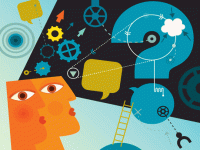6 Ways to Honor the Learning Process in Your Classroom
Your content has been saved!
Go to My Saved Content.Roughly put, learning is really just a growth in awareness. The transition from not knowing to knowing is part of it, but that's really too simple because it misses all the degrees of knowing and not knowing. One can't ever really, truly understand something any more than a shrub can stay trimmed. There's always growth or decay, changing contexts or conditions. Understanding is the same way. It's fluid.
Yes, this sounds silly and esoteric, but think about it. While morsels of information -- math theorems, for example -- may not change, the context in which students use them do change. Which in turn changes how we consider and use that morsel.
In fact, so little of the learning process is unchanging. Even what we call facts -- significant historical dates, labels for ethnic groups, causes and effects of cultural movements -- all change endlessly, if not in form (how they're discussed), then in meaning and connotation (what we think of them).
Design, engineering, religion, media, literacy, human rights, geography, technology, science -- all of these have changed both in form and connotation in the last decade, with changes in one (i.e., technology) changing how we think of another (i.e., design).
And thus changing how students use this skill or understanding.
And thus changing how we, as teachers, "teach it."
The Implications of Awareness
The implications of awareness reach even farther than that, however. It's more than merely understanding or not, while grasping the changing contexts for that understanding. It's also about becoming more aware of one's own degrees of knowing and not knowing.
This could be thought of as depth of understanding, a term that produced a depth of knowledge (DOK) framework for measuring understanding which is still used in many districts. Bloom's Taxonomy or even the TeachThought Learning Taxonomy are all tools to help evaluate understanding -- how well a student "gets it."
But learning is as much about knowing what you don't know as it is about proving what you do. An assessment can offer a guess of how much and how deeply a student understands, but that's all that it is -- a guess based on a given assessment form, a quick snapshot of student understanding at any given moment, marred by reading level, academic vocabulary, student self-efficacy, the wording of the question, or even his or her mood that morning.
The Learning Process: From Theory into Practice
Since the above may sound like a bunch of malarkey for busy teachers in public schools, following are some takeaways for putting all this theory into practice.
1. Use Learning Taxonomies
Use learning taxonomies -- and not just one -- to illuminate understanding more clearly. Seek out multiple resources to guide your instructional design. This should include assessment. Move beyond "pass or fail," or even "A-F," to "can define and apply, but has trouble analyzing."
2. Use Concept Maps
Use concept maps, and use them a lot. Have students map, chart, diagram or otherwise visually represent their own learning pathways and changes in their own understanding. Find ways for them to express what they do and don't understand, where they started, where they are, and where they might be going.
3. Use a Variety of Assessment Forms
If this is the only way you personalize learning, give it a shot. Assess student performances, writing, concept maps, drawings, interviews, projects, or maybe quick Instagram videos followed by short written responses. You can even allow students to choose their own assessment as you challenge them to prove not just if they get it, but how.
4. Build Metacognition into Units
Prime the pump by assigning students quick writing prompts about their own thinking. Model what metacognition looks/sounds/feels like. Have students share their thinking. Allow them to express themselves and their thinking away from the pressure of the classroom and the expectations of verbal eloquence. Add it to rubrics.
5. Use Digital Portfolios
Not only should you set students up with these online repositories for digital artifacts, you should frequently review what goes into them. Analyze the changes you see in student work, including content knowledge.
6. Connect Students to Networks
As students connect to networks, the learning process will plug them in, not just to one teacher, or 25 classmates, or eight texts, but to something much larger -- and more able to interact with students organically. Direct them toward communities and resources that can help move them toward knowing and understanding.
How do you honor the process of learning? Share your thoughts and strategies in the comments section below.
